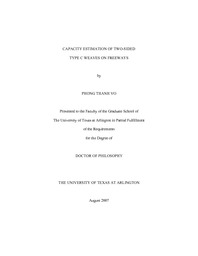
ATTENTION: The works hosted here are being migrated to a new repository that will consolidate resources, improve discoverability, and better show UTA's research impact on the global community. We will update authors as the migration progresses. Please see MavMatrix for more information.
Show simple item record
| dc.contributor.author | Vo, Phong Thanh | en_US |
| dc.date.accessioned | 2007-09-17T17:07:29Z | |
| dc.date.available | 2007-09-17T17:07:29Z | |
| dc.date.issued | 2007-09-17T17:07:29Z | |
| dc.date.submitted | July 2007 | en_US |
| dc.identifier.other | DISS-1774 | en_US |
| dc.identifier.uri | http://hdl.handle.net/10106/576 | |
| dc.description.abstract | A weaving section is a common design on major highway facilities that has been an interest to researchers for years. Weaving areas are characterized by frequent lane changes, which significantly reduce the capacity of the freeway system. The 2000 Highway Capacity Manual (HCM) defined weaving capacity as "any combination of flows that causes the density to reach the LOS E/F boundary condition of 43 pcpmpl for freeways" based on configuration, number of lanes in the weaving section, free-flow speed, length of the weave, and volume ratio (VR). However, no research has been focused on the two-sided type C weaves, which is the most difficult weave to maneuver, where one weaving movement must cross all the freeway lanes.
Simulation is the key element for this research and the VISSIM model was calibrated using the data collected in San Antonio to make sure that the model behaves the same as the observed traffic in the field. Moreover, distributions of vehicles on each lane and/or the lane changing patterns of traffic and/or gap characteristics within the weaving area were included in the simulation model. The regression model described in this dissertation is not a speed-based model, as is the model in the current HCM, but is developed to predict capacity of two-sided type C weave for the entire range of flow combinations based on simulation runs. The result found in this research is a reliable technique for evaluating a weaving performance and should be easy to explain to practitioners. | en_US |
| dc.description.sponsorship | Mattingly, Stephen P. | en_US |
| dc.language.iso | EN | en_US |
| dc.publisher | Civil & Environmental Engineering | en_US |
| dc.title | Capacity Estimation Of Two-sided Type C Weaves On Freeway | en_US |
| dc.type | Ph.D. | en_US |
| dc.contributor.committeeChair | Mattingly, Stephen P. | en_US |
| dc.degree.department | Civil & Environmental Engineering | en_US |
| dc.degree.discipline | Civil & Environmental Engineering | en_US |
| dc.degree.grantor | University of Texas at Arlington | en_US |
| dc.degree.level | doctoral | en_US |
| dc.degree.name | Ph.D. | en_US |
| dc.identifier.externalLink | https://www.uta.edu/ra/real/editprofile.php?onlyview=1&pid=968 | |
| dc.identifier.externalLinkDescription | Link to Research Profiles | |
Files in this item
- Name:
- umi-uta-1774.pdf
- Size:
- 1.864Mb
- Format:
- PDF
This item appears in the following Collection(s)
Show simple item record


